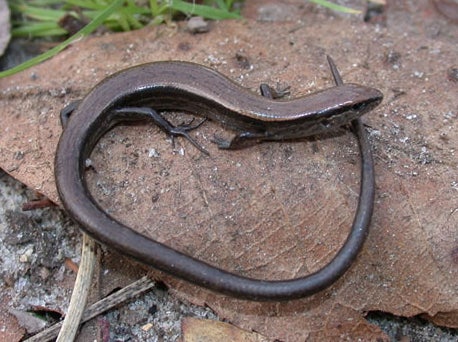SCIENTIFIC NAME:
Scincella lateralis
STATUS:
Fairly common statewide, but population densities have declined markedly in the past quarter century. Lowest Conservation Concern.
DESCRIPTION:
Ground skinks are one of the smallest reptiles in the United States. They normally range from 3-6 inches in length. Like most skinks, they have relatively short legs and a thin, elongated body. Their color varies from a light, golden brown to almost black with a bronze tint. A broad dark stripe extends down both sides of the body from the nostrils through the eyes to the tail. Their bellies and undersides are yellowish white in color. Ground skinks have a transparent disk in the lower eyelid (known as a nictitating membrane) that covers and protects the eye.
DISTRIBUTION:
Ground skinks range throughout the eastern United States, from Kansas to the East Coast, south to the Florida Keys, and as far west as northern Mexico. They are most common in the Coastal Plain and eastern Piedmont regions. They are not found on the higher elevations of the Appalachian Mountains.
HABITAT:
Ground skinks inhabit dry, open, deciduous and mixed deciduous/coniferous forests which have abundant leaf litter. They can also be found along the edges of grass lands, ponds, and streams. They prefer loose soils and plant materials such as, rotting leaves, mosses, and fallen logs.
FEEDING HABITS:
Ground skinks feed on a variety of tiny spiders, insects, isopods, and other invertebrates.
LIFE HISTORY AND ECOLOGY:
Ground skinks are a fossorial species, spending most of their lives buried under leaves and other plant materials on the forest floor. They “run” by using their slender bodies to “swim” or make lateral wiggling movements through and under leaves and in loose soils. Unlike many other skinks, ground skinks typically do not climb trees. They are normally diurnal (active in the day). Their nests are constructed of leaves and soil under fallen rotten trees, rocks, and other debris. Ground skinks lay small clutches of one to seven eggs. They may lay up to five clutches between April and August. The female does not guard her eggs, nor does she care for the young. The eggs hatch one to two months after they are laid. Young ground skinks become sexually mature at one year of age. Ground skinks are very reclusive and disappear quickly under cover if disturbed. They will enter water when pursued. Like many lizards and skinks, if a predator seizes a ground skink by its tail, fracture planes in the caudal vertebrae allow the tail to break off. The severed tail will continue to move for several minutes, providing a distraction and partial meal to the predator, while the skink flees for safety. If the skink survives, it eventually will regenerate (re-grow) its tail.
REFERENCES:
Conant, Roger and Collins, Joseph T. 1998. Peterson Field Guides, Reptiles and Amphibians. Houghton Mifflin Company, NY., NY. 616 pp.
National Audubon Society. 1979. Field Guide to Reptiles and Amphibians, North America. Chanticleer Press, Inc. 743 pp.
Author:
Daniel Toole, Wildlife Biologist, Alabama Division of Wildlife and Freshwater Fisheries






